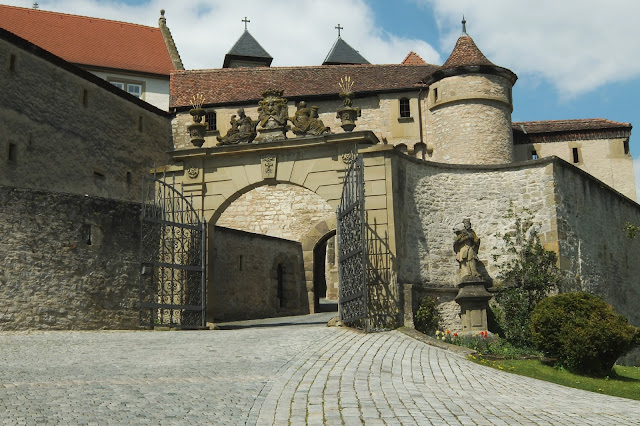 |
| St. Michael's, Schwabisch Hall |
Schwabisch Hall
Schwabisch Hall is located at about the halfway point between Strasbourg and Nuremberg. For short, locals call the name Hall, giving it something of a Tolkien feel to it—though this was actually its earlier name, as the Schwabisch part wasn’t thrown on until the Nazis. Hall was built on the steep valley walls of the Kocher River in the 5th century and expanded as a salt production center. It now serves as a university town, much like the nearby city of Tubingen.
 |
| A channel off the Kocher |
We parked our car on the East side of the slowly meandering river, in a garage that appeared to be a half-timbered house from the outside. The wood-roofed pedestrian bridge took us to a small island where there’s a beer garden and a scaled-down replica of Shakespeare’s Globe Theatre, where they must do scaled-down versions of his comedies and tragedies. It’s a fantastic view from the beer garden, seeing the old stone walls holding the city above the Kocher and the houses hanging over the walls.
On the other side of the river, there’s something of a switch back road, walled on either side by towering half-timbered houses, until at last you reach the main square with the 15th century St. Michael’s Church high up on a storm of stairs—the Freilicht Spiele, used as an outdoor theatre since 1925—and opposite and much lower, the 18th century city hall.
 |
| View from St. Michael's |
The best times to visit Hall are on Whitsunday (the seventh Sunday after Easter) for the Cake and Source Festival, where some 500 people dress up in costume for the salt mine cleaning ceremonies that have been going on for some half a millennium. Then there’s the International Muzzleloader Shooting festival, which is enough to make any American-liberal-worried-overmuch-about-cultural-appropriation blush quite red in the face. At this festival, there’s a bunch of Germans who are celebrating the American Wild West by dressing up as Native Americans, sleeping in teepees, and having a musket shooting contest. This weird awesome sounding fest isn’t complete without country music bands and cowboy boots for sale.
Comburg Monastery
If you get at just the right angle from the island, you can sort of make out a castle on a hilltop up the valley. Otherwise though, you could visit Hall without even knowing there was a massive castle-monastery a 3-minute drive away. The monastery was founded back in the 1070s by the Counts of Comberg-Rothenburg on the site of their castle. The monks there were all of noble birth, the rejects of the family that didn’t fall in line with primogeniture and whose father’s thought it best that they at least become esteemed maesters of the royal families. Wait – no I’ve got my real history mixed up with my Game of Thrones again. Or vice versa. But really, that sort of thing actually happened. Making your other sons monks did have a way of settling squabbles of inheritance.
 |
| The entrance of the monastic castle |
The monastery was secularized in the early 19th century and is now used as a teaching school, where they have various teachers’ conferences year round. It would certainly be pretty awesome to have a week long training conference in a castle! I’m waiting for my company to get around to doing one of those…
 |
| The outer courtyard |
Neumarkt in der Oberfalz
Finally, our driving adventure brought us to Neumarkt in der Oberfalz. Despite being founded in 6th century AD, Neumarkt looked as though it were only just built. Clean streets, freshly painted and built houses, the town looked like it had recently underwent a renaissance. The streets were quiet and nicely paved with a large and busy town center. The town is mostly famous for its Nazi past—Dietrich Eckart, one of the founders of the party, was born there and one of the first local chapters of the country formed there.
 |
| the town gate from the main parking garage |
The most interesting site in the town we had to miss though, since we were pretty ready to end our trip and get back to the regularly scheduled program in Prague. We could see Bergruine Wolfstein as we passed on our way back to the autobahn, its crumbling towers standing over us. The place has supposedly been pretty incredibly renovated, so I regret that we didn’t get to stop, but home was waiting.
 |
| the town square |

That first stop looked and sounded like fun.
ReplyDeleteEspecially during the Muzzleloader Shooting Festival. Would definitely like to check that one out.
Delete